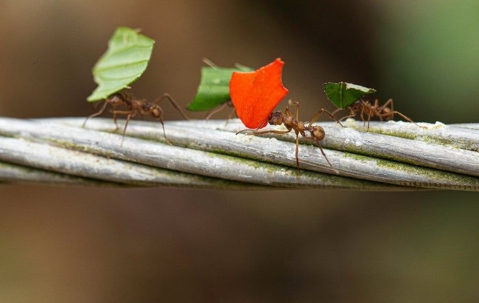7 Invasive Ants in WPB and Why They're a Problem
You might have heard the term “invasive species” before, but do you know what makes a species invasive?
An invasive species is defined as a “non-native species that causes harm to the environment, economy, or human, animal or plant health.”
There are a few parts to this. First, an invasive species is “non-native.” A species can be non-native without being invasive; however, it can’t be native to be considered invasive.
The next part is that it has to cause harm to the environment, economy, human, animal, or plant health. This means that an invasive species must be a threat to the areas it has spread in some way.
Many of these ants, threaten the environment because of their mutual relationship with sap-sucking insects including aphids, whiteflies, mealybugs, and scale. Ants will farm these bugs so they continue producing an ant-favorite food source known as honeydew.
It is great for the ants to have such a tasty snack at their fingertips (?) at all times, but it’s not great for anyone who owns plants infested with these bugs or ants. This is because the sap-sucking insects can spread plant diseases such as cucurbit leaf crumple and pineapple wilt disease.
If you find you have an invasive ant species in your home, it is especially important to get it under control. Keep reading to learn the different types of invasive ant species, their traits, what makes them a problem, and what to do about them.
Red Imported Fire Ant (RIFA)
The red imported fire ant is one of two major invasive fire ant species. It came to the U.S. sometime between 1933 and 1945 from South America.
The RIFA is considered an especially problematic invasive ant species due to its extreme aggression. This is because of its venomous sting and its ability to out-compete native ant species, proving to be a threat to their populations.
They’re currently around Florida, Georgia, California, South Carolina, Tennessee, Alabama, Mississippi, Arkansas, Texas, and Oklahoma.
This ant is also considered invasive due to its damage to the economy. In California, nursery products like potting soil need to be placed in special quarantines to protect them from infestations.
Red imported fire ants are reddish-brown and ? inch to ¼ inch long. You’ll usually find them outside because of their 3 favorite things: Soil, sun, and water.
How Do I Get Rid of Red-Imported Fire Ants?
- Pour boiling water on the ant mound.
- Pour insecticides on the ant mound.
- Sprinkle ant bait on the ground where you think the ant nest is near
- Spread broadcast insecticide treatment throughout your yard. This treatment covers up to 5,000 square feet, so it’s made to target entire colonies.
These are all methods you can use without professional help; however, hiring a pest control company is always recommended for ant infestations.
Native Pest Management uses the best quality broadcast baits that can quickly eliminate a red imported fire ant infestation.
If you have fire ants in or around your home, don’t settle with the discomfort they bring. Get in touch with Native Pest Management now so we can quickly resolve your fire ant issue.
2. Tropical Fire Ant
The tropical fire ant is closely related to the red imported fire ant, just less common in West Palm Beach.
It can be difficult to distinguish between the two, but it’s good that they’re less common because the tropical fire ant has a sting that’s much more painful.
They’ll sting anyone that disturbs their nest and can cause a reaction of raised red itchy bumps that last for days.
The tropical fire ant can also be distinguished by their habitat–while the red imported fire ant nests in mounds, tropical fire ants spread dirt around the nest entrance.
These ants can form two kinds of colonies, either polygyne or monogyn. The polygyne colonies have multiple queens and can spread through budding, in which ants split and form new nests.
Monogyne colonies have one queen and live in only one nest, so if you see only one fire ant nest on your lawn that isn’t an ant mound, it’s most likely a tropical fire ant nest.
What makes them invasive beyond their non-native status is the damage they can cause. Tropical ant workers are known to chew through hoses, feed on seeds and crops, and even eat reptile eggs.
How Do I Get Rid of Tropical Fire Ants?
Above I mentioned that it’s much more likely that you’ll find red imported fire ants on your lawn than tropical fire ants.
Similar to red imported fire ants, we use broadcast bait treatments to get rid of tropical fire ants. You can do this on your own; however, we recommend that you call a professional fire ant exterminator in West Palm Beach.
3. Big Headed Ants
The big-headed ant is an invasive species to Florida from Africa. Today in West Palm Beach, big-headed ants live in supercolonies.
This means big-headed ant colonies can be so big, that they don’t just limit themselves to one home–they’ll often spread across multiple on a street.
These ants can also cause economic problems by disrupting irrigation and utility lines. They also tend to spread through commerce, so inspect your packages thoroughly before taking them inside. You could unknowingly be bringing a bigheaded ant infestation into your home.
Big-headed ants are a major invasive species issue worldwide and are currently in the top 100 most threatening invasive species. So by controlling them, you could be making a big difference!
How Do I Get Rid of Big-Headed Ants?
Big-headed ant infestations are extremely difficult to control considering their large colony numbers. We recommend you get in touch with Native Pest Management so your home can quickly become ant-free.
4. White Footed Ants
White-footed ants usually show up at homes when people bring in new landscaping, such as trees and shrubs that were already infested upon arrival.
White-footed ant infestations reach extremely high numbers, and the reason for this is that they have an unusually high number of reproductive queens in a colony, sometimes making up half the colony.
Eliminating white-footed ants is tricky enough that it typically takes pest control companies more than one treatment to kill an entire colony.
How Do I Get Rid of White-Footed Ants?
The best way to get rid of white-footed ants is to remove the source. Sap-sucking insects like whiteflies, aphids, mealybugs, and scale insects often infest trees, shrubs, and indoor plants.
By controlling these insects–which you can do by applying products such as Dominion 2L, Tristar, Meridian, and Acelpryn–you can eliminate white-footed ants.
We also recommend the use of granular or liquid baits to get rid of white-footed ants. If you use liquid baits, monitor and reapply regularly since liquid baits can dry out quickly.
5. Argentine Ants
What’s interesting about argentine ants is that they make up the world’s largest super colony–ranging over 6,000km in the Mediterranean region.
This supercolony has millions of ant nests and billions of ant workers. And yeah, if you didn’t already know, there are far more ants in the world than people (about 20 quadrillion).
Native to Argentina, Uruguay, Paraguay, Bolivia, and Brazil, the Argentine ant is another species that ranks in the 100 most-threatening invasive species.
Argentine ants are found in southern states (including Florida), California, and Hawaii. Outside the United States, they’re found in New Zealand, South Africa, Japan, Australia, and southern Europe.
How Do I Get Rid of Argentine Ants?
To get rid of Argentine ants, the most effective method is using a slow-acting bait. If a bait responds too quickly, the ants will know what’s happening and a process called budding will occur. The unaffected ones will split from the group and create new colonies, just to multiply and populate your home even more.
Native Pest Management uses slow-acting baits that can reach every ant, including the queen before it starts working.
To reduce the stress of having to do this process on your own, give us a call today for the smoothest ant control treatment you can get, all with pet-friendly and eco-friendly products.
6. Ghost Ants
Ghost ants have an unknown origin; however, most believe it’s either African or Asian.
They get their name from how they look: Almost invisible, like ghosts. They have clear bodies and dark heads. Plus, they’re tiny so it can take a bit of work to find them.
Ghost ants are mostly indoor pests. You’ll find them in dark, moist areas around your home like in between wall voids or behind baseboards.
But they’re still around outside too, and you can spot them in the ground, under leaves, stones, or bricks.
They can also only survive in warm weather, which means there are few spots where they can survive year-round, and West Palm Beach is one of those spots.
How Do I Get Rid of Ghost Ants?
Cleaning and sealing entry points in your home can do wonders, particularly in the kitchen and bathroom. But sometimes that isn’t enough, especially when there’s already a large colony in your home.
This is another case where slow-acting baits are the way to go. The best way to go about that is to leave it to pest control professionals. If you want all the ghost ants in your home to go away quickly and effectively, call Native Pest Management and we can do it, guaranteed.
7. Pavement Ants
Pavement ants are outside lovers. They’ll hang out on your patio all day and night, whether you like it or not.
They’re also rapidly spreading invasive pests. Scientists theorize that they came from Europe back in colonial times. Today, they’re a problem due to their aggressive behavior.
They’re known for their habit of fighting other ants. Because of this, they’ve managed to spread widely across North America as one of the most highly populated species.
They become even more active as the temperatures rise, so summers in West Palm Beach can prove to be an intense time in the world of ant battles.
How Do I Get Rid of Pavement Ants?
Since pavement ants typically live outside, you can keep them out by sealing openings in your home. Caulk, as I talked about before, is a powerful tool for this.
Getting them off of your patio is another story. To get pavement ants off the patio, you’ll want to use bait and it goes the same way I’ve explained throughout this post–slow working is always best!

Ant Control for Invasive Ants in West Palm Beach
Red imported fire ants, big-headed ants, white-footed ants, Argentine ants, ghost ants, and pavement ants in West Palm Beach have been living comfy for a bit too long.
By taking down colonies, even just a few, you would be doing a lot for the economy, the environment, the native populations (even though we don’t like them either), and your home!
The tips provided in this article are effective–but they’re only temporary. To fully get rid of invasive ant colonies in your home, the best method is to call pest control for long-lasting treatments.
By setting up a quarterly ant control plan with us, you’ll never have to worry about ants again because by coming quarterly, we’re focused on prevention.
And with this plan, we won’t just go after ants. Our quarterly home pest control plan fights against cockroaches, spiders, silverfish, millipedes, and earwigs too.
To stop invasive ants and other nuisance pests in your home, give us a call today!
